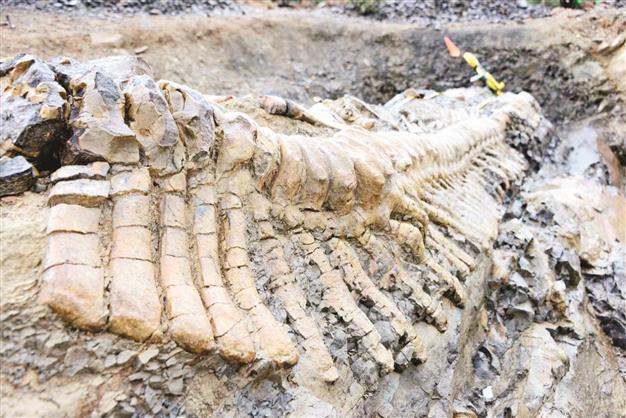Archaeologists discover dinosaur tail in Northern part of Mexico
MEXICO - REUTERS

A huge fossilized tail of a duck-billed dinosaur, or hadrosaur, is seen in the Municipality of General Cepeda, Coahuila in Northen part of Mexico. REUTERS photo
A team of archaeologists have discovered the fossilized remains of a 72 million-year-old dinosaur tail in a desert in northern Mexico, the country’s National Institute for Anthropology and History (INAH) said on July 22.Apart from being unusually well preserved, the 5 meter (16 foot) tail was the first ever found in Mexico, said Francisco Aguilar, INAH’s director in the border state of Coahuila.
The team, made up of archaeologists and students from INAH and the National Autonomous University of Mexico (UNAM), identified the fossil as a hadrosaur, or duck-billed dinosaur.
The tail, found near the small town of General Cepeda, likely made up half the dinosaur’s length, Aguilar said.
Archaeologists found the 50 vertebrae of the tail completely intact after spending 20 days in the desert slowly lifting a sedimentary rock covering the creature’s bones.
Strewn around the tail were other fossilized bones, including one of the dinosaur’s hips, INAH said. Dinosaur tail finds are relatively rare, according to INAH. The new discovery could further understanding of the hadrosaur family and aid research on diseases that afflicted dinosaur bones, which resembled those of humans, Aguilar said.
Scientists have already determined that dinosaurs suffered from tumors and arthritis, for example.
Dinosaur remains have been found in many parts of the state of Coahuila, in addition to Mexico’s other northern desert states.
“We have a very rich history of paleontology,” Aguilar said.
He noted that during the Cretaceous period, which ended about 65 million years ago, much of what is now central northern Mexico was on the coast. This has enabled researchers to unearth remains of both marine and land-based dinosaurs.
















